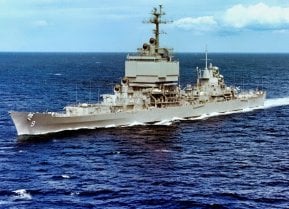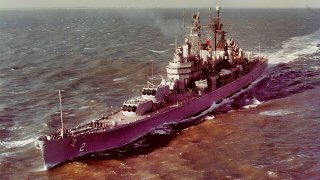Boston-Class: How the U.S. Navy Built Guided-Missile Cruisers
The Boston-class, emerging from the transformation of Baltimore-class heavy cruisers, marked the U.S. Navy's foray into the era of guided-missile cruisers.
Summary: The Boston-class, emerging from the transformation of Baltimore-class heavy cruisers, marked the U.S. Navy's foray into the era of guided-missile cruisers. Initially designed without the constraints of the London Naval Treaty, the Baltimore class served with distinction during World War II, known for their speed, heavy armament, and versatility. The transition to the Boston class involved significant modifications, including the introduction of Terrier anti-aircraft guided missiles, consolidating their place in naval history as pioneers of missile warfare.
The Boston-Class: America's First Guided-Missile Cruisers
The Boston-class gave the U.S. Navy the world’s first array of guided-missile cruisers. The class had humbler origins as Baltimore-class heavy cruisers. Through its various iterations, the Baltimore/Boston-class vessels served from the early 1940s until 1970.
The Baltimore-class of heavy cruisers was commissioned during and after World War II. Fourteen of these ships were completed, making the Baltimores the most heavily produced heavy cruiser class. It was the first Navy vessel designed outside the limitations of the London Naval Treaty.
The Baltimore-class was fast and heavily armed. The ships relied on 8-inch main guns and 5-inch secondary guns to protect aircraft carriers from air attack. The Baltimore was also used to bomb land targets in support of amphibious landings.
Each Baltimore-class vessel cost $40 million. They were built between 1941 and 1945. The vessels had a displacement of 17,000 tons when fully loaded. They measured 664 feet along the water line and 70 feet at the beam, with a height of 112 feet and a draft of 26 feet. For propulsion, the Baltimore relied on four Babcock & Wilcox boilers, four screws, and four steam turbine sets. The ships could reach an impressive 33 knots.
The Baltimore-class sailed with 61 officers, 1,085 sailors, two life rafts, two aircraft catapults, and later a helipad. The aircraft catapults were especially noteworthy. They were set aboard the vessel’s side edges on the aft deck. Between them was a sliding hatchway that led to an onboard hangar beneath the deck of the ship that could house four aircraft.
The Vought OS2U Kingfisher, and later the Curtiss SC-1 Seahawk, were used for reconnaissance, anti-submarine warfare, and rescue missions. Launched from the Baltimores’ catapults, these seaplanes landed in the water near the cruisers before being lifted by crane onto the rear of the ships.
The first ship in the Baltimore-class was launched in July 1942. The second ship in the class, the Boston, was commissioned in June 1943 and decommissioned in October 1946. But the Boston’s story was only beginning.
The Boston-Class
Two Boston-class cruisers were commissioned, starting with the namesake vessel, the USS Boston. After being decommissioned as a Baltimore-class vessel, the Boston underwent a lengthy conversion and modernization project known as SCB 48.
The conversion involved removing the Boston’s aft triple 8-inch gun turret to make room for Terrier anti-aircraft guided-missile launchers. The vessel’s superstructure was converted to include all of the radar and electronics systems that complemented the Terrier missiles. The ship’s two funnels were trunked into one.
The USS Boston was recommissioned as CAG-1 in November 1955. The second in the class, the USS Canberra (CAG-2), was recommissioned in June 1956, completing the Boston class.
The finished Boston-class ships measured 673 feet, with similar propulsion systems to the Baltimore. The boilers generated 4,615 pounds per square inch of pressure, capable of propelling the ship to the same top speed of 33 knots.
In the 1950s, the Boston class sailed with AN-SPS-6 air-search radar; AN/SPS-8A height-finding radar; AN/SPS-10 surface-search radar; AN/SPS-12 air-search radar; AN-SPQ-5 fire-control radar; and a CXRX hemisphere-scan radar.
By the 1960s, however, the Boston’s radar systems were upgraded to the AN/SPS-13 air-search radar; AN/SPS-29 early-warning radar; AN/SPQ-5 fire-control radar; AN/SPG-35 fire-control radar; and the AN/URN-3 TACAN.
In 1968, the Boston-class guided-missile cruisers were reclassified back to heavy cruiser (CAs), in large part because of consistent shore bombardments during the Vietnam War using their 8-inch guns. The Boston class still had the Terrier missiles, which had granted the vessel CAG status. But by the 1960s, the Terrier was out of date, and the Boston once again relied on her 8-inch guns as the primary offensive weapon.
By the late 1960s, with the 1940s-era cruisers becoming increasingly obsolete, various modernization proposals were considered. Each proposal was ultimately rejected, however, and in 1970 both Boston-class vessels were decommissioned for the final time and sold for scrap.
About the Author: Harrison Kass
Harrison Kass is a defense and national security writer with over 1,000 total pieces on issues involving global affairs. An attorney, pilot, guitarist, and minor pro hockey player, Harrison joined the US Air Force as a Pilot Trainee but was medically discharged. Harrison holds a BA from Lake Forest College, a JD from the University of Oregon, and an MA from New York University. Harrison listens to Dokken.


